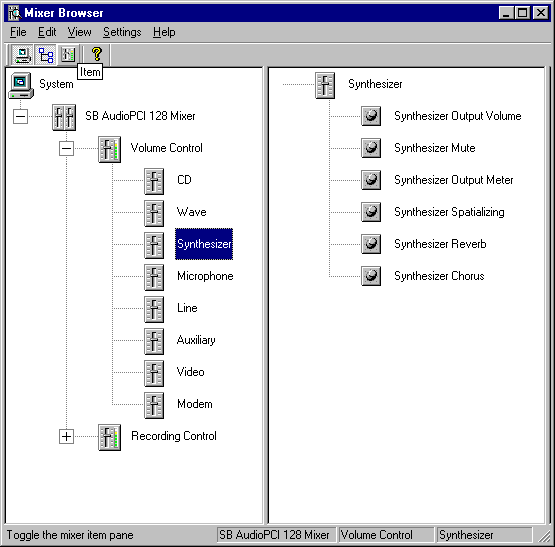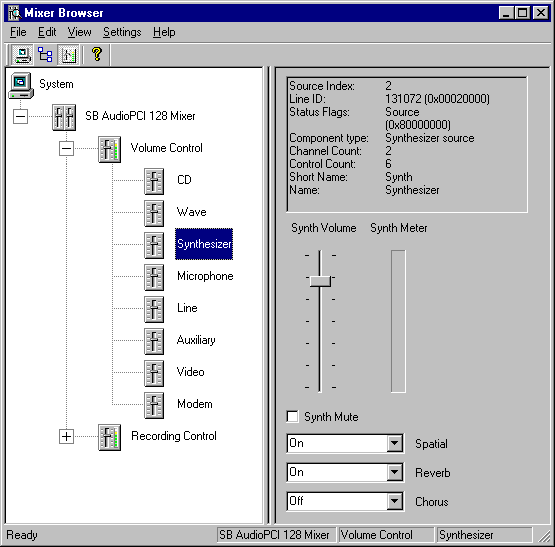
This page is a companion resource to the author's presentation of the Windows mixer system. The Mixer Browser utility is a study tool giving access to the internals of Windows mixer resources. It has also become a handy tool for analysis and automatic configuration of audio settings.
The utility opens the active mixer framework for detailed user inspection and manipulation of individual settings. The program presents the hierarchical structure of the mixer system in a tree view presented in three sections: The System, Node and Item Panes.
The panes may be selected with dedicated buttons on the tool bar. Every node may be expanded and collapsed from the standard tree view check boxes. The detailed status information of the mixer resources can be studied by activating the relevant node with the enter key or a double-click with the mouse.
The audio routing of the current selection is displayed on three panes of the status bar In order to facilititate navigation. Depending on the current selection mixer, destination and source line status are indicated.

The leftmost System Pane presents a full analysis of the current mixer hierarchy, with the system on the top and mixers, destination and source lines at the lower levels of the tree view. The pane contains the following nodes: Host system, mixer, destination and source.
The content of the Node Pane depends on the current selection in the System Pane. It may contain:
The Item Pane focuses mainly on the controls of destination and source lines, either as a complete control enumeration or as individual controls. The mixer controls are mapped to standard Windows controls which give direct access to the details of the mixer machinery.

The program is also useful in managing the configuration audio resources in various settings, such as multimedia conferencing, netcasting or presentation. The user may save and reload switch, fader, slider and list settings, which provides an easy way to secure a stable set of configurations for various situations. The settings are stored in configuration files with the type .mix, which is associated with the application. The new settings may be triggered by double-clicking the file icon or by dragging it into the client area of the application.
The store and reload operations may also be executed silently from a command line in a shortcut, from the start menu Run dialog or even in a batch file. By placing a MixerBrowser shortcut in the Startup section of the Start menu the user may ensure a certain default setting for the relevant user profile.
The syntax for command line execution is:
| Command line | Operation executed |
|---|---|
MixerBrowser <filepath>.mix |
Loads mixer settings and runs the application in interactive mode |
MixerBrowser -store:<filepath>.mix |
Stores current mixer settings |
MixerBrowser -load:<filepath>.mix |
Loads stored mixer settings |
MixerBrowser -help |
Displays the command line syntax |
Success and failure can be tracked with the DOS errorlevel parameter.
Although the audio mixer system has remained intact in Windows Vista, the archicture has undergone several changes, which affect the functionality of the utility. Individual applications - and Mixer Browser is only of them - operate an application specific virtual mixer without affecting the settings of any other sound devices.
Driver names also used to be limited to 32 characters, but Vista drivers may now be considerably longer. This may affect mixer destination and source line names by chopping overlong product names.
The application is being developed on a Windows Vista machine and tested on Windows XP SP1 and SP2 workstations.
— Philip Donner